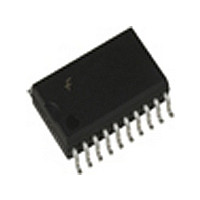74ACT715SCNL Fairchild Semiconductor, 74ACT715SCNL Datasheet - Page 10

74ACT715SCNL
Manufacturer Part Number
74ACT715SCNL
Description
Manufacturer
Fairchild Semiconductor
Datasheet
1.74ACT715SCNL.pdf
(18 pages)
Specifications of 74ACT715SCNL
Lead Free Status / RoHS Status
Compliant
©1988 Fairchild Semiconductor Corporation
74ACT715, 74ACT715-R Rev. 1.3
ADDRDEC Logic
The ADDRDEC logic decodes the current address and
generates the enable signal for the appropriate register.
The enable values for the registers and counters change
on the falling edge of LOAD. Two types of ADDRDEC
logic is enabled by 2 pair of addresses, Addresses 22 or
54 (Vectored Restart logic) and Addresses 23 or 55
(Vectored Clear logic). Loading these addresses will
enable the appropriate logic and put the part into either a
Restart (all counter registers are reinitialized with prepro-
grammed data) or Clear (all registers are cleared to
zero) state. Reloading the same ADDRDEC address will
not cause any change in the state of the part. The
outputs during these states are frozen and the internal
CLOCK is disabled. Clocking the part during a Vectored
Restart or Vectored Clear state will have no effect on the
part. To resume operation in the new state, or disable
the Vectored Restart or Vectored Clear state, another
non-ADDRDEC address must be loaded. Operation will
begin in the new state on the rising edge of the non-
ADDRDEC load pulse. It is recommended that an
unused address be loaded following an ADDRDEC oper-
ation to prevent data registers from accidentally being
corrupted. The following Addresses are used by the
device.
Address 0
Address 1–18
Address 19–21
Address 22/54
Address 23/55
Address 24–31
Address 32–50
Address 51–53
Address 56–63
At any given time only one register at most is selected. It
is possible to have no registers selected.
Vectored Restart Address
The function of addresses 22 (16H) or 54 (36H) are sim-
ilar to that of the CLR pin except that the preprogram-
ming of the registers is not affected. It is recommended
but not required that this address is read after the initial
device configuration load sequence. A 1 on the
ADDRDATA pin (Auto Addressing Mode) will not cause
this address to automatically increment. The address will
loop back onto itself regardless of the state of
ADDRDATA unless the address on the Data inputs has
been changed with ADDRDATA at 0.
Vectored Clear Address
Addresses 23 (17H) or 55 (37H) is used to clear all regis-
ters to zero simultaneously. This function may be desir-
able to use prior to loading new data into the Data or
Status Registers. This address is read into the device in
a similar fashion as all of the other registers. A 1 on the
Status Register REG0
Data Registers REG1–REG18
Unused
Restart Vector (Restarts Device)
Clear Vector (Zeros All Registers)
Unused
Register Scan Addresses
Counter Scan Addresses
Unused
10
ADDRDATA pin (Auto Addressing Mode) will not cause
this address to automatically increment. The address will
loop back onto itself regardless of the state of
ADDRDATA unless the address on the Data inputs has
been changed with ADDRDATA at 0.
Gen Locking
The ACT715 and ACT715-R is designed for master
SYNC and BLANK signal generation. However, the
devices can be synchronized (slaved) to an external tim-
ing signal in a limited sense. Using Vectored Restart, the
user can reset the counting sequence to a given loca-
tion, the beginning, at a given time, the rising edge of the
LOAD that removes Vector Restart. At this time the next
CLOCK pulse will be CLOCK 1 and the count will restart
at the beginning of the first odd line.
Preconditioning the part during normal operation, before
the desired synchronizing pulse, is necessary. However,
since LOAD and CLOCK are asynchronous and inde-
pendent, this is possible without interruption or data and
performance corruption. If the defaulted 14.31818MHz
RS-170 values are being used, preconditioning and
restarting can be minimized by using the CLEAR pulse
instead of the Vectored Restart operation. The ACT715-R
is better suited for this application because it eliminates
the need to program a 1 into Bit 10 of the Status Register
to enable the CLOCK. Gen Locking to another count
location other than the very beginning or separate
horizontal/vertical resetting is not possible with the
ACT715 nor the ACT715-R.
Scan Mode Logic
A scan mode is available in the ACT715 that allows the
user to non-destructively verify the contents of the regis-
ters. Scan mode is invoked through reading a scan
address into the address register. The scan address of a
given register is defined by the Data register address + 32.
The internal Clocking signal is disabled when a scan
address is read. Disabling the clock freezes the device in
it's present state. Data can then be serially scanned out
of the data registers through the ODD/EVEN Pin. The
LSB will be scanned out first. Since each register is
12 bits wide, completely scanning out data of the
addressed register will require 12 CLOCK pulses. More
Figure 5. ADDRDEC Timing
www.fairchildsemi.com




















